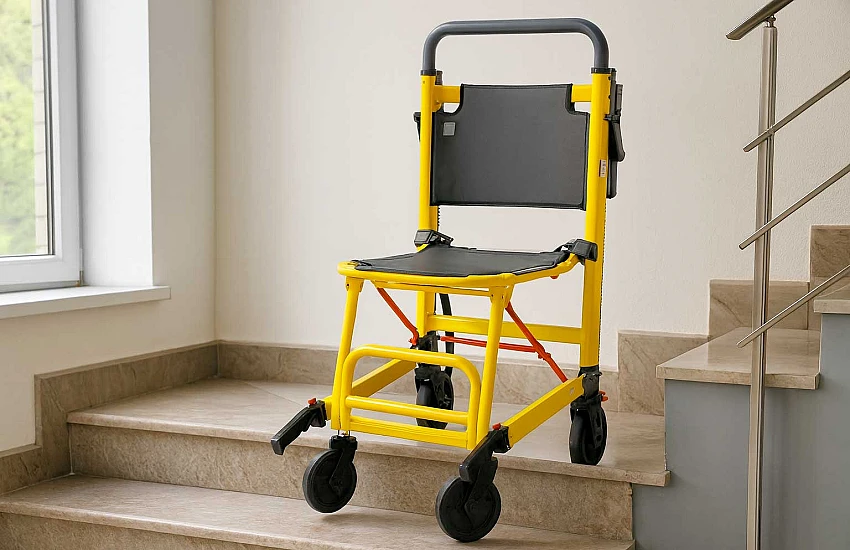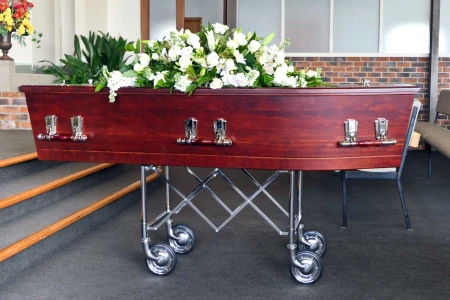Table of Contents
- Modern Rescue - The Evolution of Emergency Transport
- Types of Transport Chairs
- What is a Stair Climber Transport Chair?
- Comparison: Standard Transport Chair vs. Stair Climber Transport Chair
- Key Advantages of the Stair Climber Chair
- Technical Specifications of the Stair Climber Transport Chair
- Technical Parameters
- Benefits of Using a Transport Chair
- Efficiency of Rescue Operations
- Versatile Applications
- Stair Climber Chair Operating Procedures
- Maintenance and Maintenance
- Use Cases – Real-World Studies
- The Future of Emergency Transport Technology
- Summary
Stair climber transport chairs are modern rescue devices equipped with an advanced track system, enabling the safe evacuation of people from multi-story buildings. With a load capacity of up to 160 kg and the ability to be operated by a single operator, these chairs are revolutionizing the operations of emergency services, medical facilities, and public safety systems. This article provides a detailed comparison with traditional transport methods, technical specifications, and practical applications in crisis situations. Learn how the Prima-Tech stair climber can increase the efficiency and safety of your rescue operations.
Modern Rescue - The Evolution of Emergency Transport
Faced with growing public safety challenges, emergency services worldwide are seeking increasingly advanced technological solutions. Stairclimbers represent a breakthrough in rescue, offering reliable and safe evacuation methods in situations where traditional approaches fail.
Modern cities are characterized by an increasing number of multi-story buildings, often without elevators or with elevators that are unreliable in emergency situations. Statistics show that over 40% of rescue interventions take place in buildings above the third floor, where transporting injured people poses the greatest logistical and safety challenges.
The demographic aging of the population further increases the need for specialized transport equipment. Elderly people, often with limited mobility, constitute a growing percentage of the population requiring assistance in emergencies. Traditional evacuation methods, based on rescue teams carrying equipment, are proving not only dangerous but also insufficient in the face of growing needs.
It is in response to these challenges that stairlift transport chairs with a tracked system were developed – devices that combine advanced technology, ergonomics, and reliability. They allow a single trained operator to safely transport a person of significant body weight up stairs, regardless of the configuration or environmental conditions. Stairlift Transport Chairs in Security Services
Stairlift transport chairs are advanced medical and emergency equipment that are revolutionizing the evacuation and transport of people in crisis situations. In the era of modern multi-story buildings, where traditional evacuation methods often fail, the evacuation chair is becoming an indispensable piece of equipment for emergency services, medical facilities, and public safety systems.
Thanks to the advanced tracked system, a single stairlift transport chair allows a single operator to safely evacuate a person weighing up to 160 kg, significantly streamlining rescue operations and minimizing the risk of injury to both evacuees and rescuers.

Applications of Stair Climbers and Transport Chairs
Emergency Services and Fire Departments
Evacuation chairs are a key piece of equipment for emergency services in situations such as:
- Fire evacuation - when elevators are out of service and traditional stairlifting is impossible due to smoke or time constraints.
- Rescue operations in high-rise buildings - rapid evacuation of people with disabilities or injuries from upper floors.
- Crisis situations - natural disasters, gas explosions, structural collapses requiring immediate evacuation.
- Transportation in difficult-to-access areas - narrow stairwells, steep stairs, and curves that prevent the use of stretchers.
Medical Facilities and Hospitals
Patient transport chairs are widely used in healthcare:
- Patient transport between floors - when elevators are out of service or occupied by other services.
- Evacuation of hospital wards - in emergency situations requiring the transfer of bedridden patients. Ambulances - transporting patients from residential buildings, especially the elderly and people with disabilities.
- Rehabilitation and physiotherapy - safely transporting patients to treatment rooms on different floors.
Public Buildings
Transport chairs are increasingly being installed in:
- Offices and institutions - ensuring accessibility for people with disabilities.
- Schools and universities - as part of an evacuation plan for people with limited mobility.
- Shopping malls - providing rapid assistance in the event of injuries or health problems for customers.
- Hotels and guesthouses - evacuating guests in emergency situations.
Apartments and Private Homes
Stair climbers are used in private homes:
- Senior care - enabling older people to leave their homes safely.
- People with disabilities - increasing mobility and independence.
- Medical emergencies - transporting a sick person to an ambulance.
- Emergency planning - preparing for situations requiring evacuation.
Types of Transport Chairs
Mechanical Transport Chairs
The mechanical transport chair utilizes a gravity system with precise braking:
- Load capacity up to 160 kg - sufficient for most adults
- Track system - ensures smooth and controlled descent down stairs
- Telescopic handles - adjusted to the operator's height
- Seat belts - multi-point security for the evacuee
- Foldable design - easy storage and transport
Specialized Evacuation Chairs
Evacuation chairs adapted to specific applications:
- Hospital models - with additional holders for medical equipment
- Emergency versions - reinforced structure for use in extreme conditions
- Universal chairs - adapted to various types of evacuations
- Compact models - for narrow spaces and tight buildings

What is a Stair Climber Transport Chair?
The Stair Climber Transport Chair is a specialized rescue chair designed for evacuation and transport of people in emergency situations. It is equipped with a modern track system that facilitates safe and gradual descent down stairs, minimizing the risk of injury.
An example of a professional transport chair is the Stair Climber Chair offered by Prima-Tech, characterized by the highest quality of workmanship and reliability in rescue operations.
Key Features of the Stair Climber Chair
The track system allows for safe and smooth descent down stairs, minimizing the risk of injury. Special tracks with a non-slip profile ensure stability on all types of surfaces.
- Ergonomic Design - The chair is designed with the comfort of the user and rescuers in mind, making transport easier in stressful situations.
- Telescopic Handles - Folding handles allow for easy height adjustment, increasing comfort and reducing back strain on the operator. Adjustable seat belts – multi-point safety ensures the evacuee's stability during transport.
- Comfortable armrests – increase comfort and a sense of security for the person being transported.
Comparison: Standard Transport Chair vs. Stair Climber Transport Chair
Choosing the right transport chair is crucial in situations where evacuation is necessary. Below is a detailed comparison of standard transport chairs and stair climber transport chairs.
| Features | Standard Transport Chair | Stair Climber Transport Chair |
|---|---|---|
| Intended Use | General transport of people on flat surfaces | Emergency evacuation, especially on stairs |
| Transport System | Standard wheels for movement on flat surfaces | Modern track system for safe descent down stairs |
| Load Capacity | Typically up to 120 kg (depending on the model) | Typically up to 160 kg or more (depending on the model) |
| User Comfort | Limited ergonomics, less comfortable for the person being transported | Ergonomic design with armrests and seat belts for increased comfort |
| Weight and Transport | Typically heavier and more difficult to maneuver | Lighter and easier to maneuver thanks to the track system |
| Complexity | Simple to use, requiring two people for transport on stairs | Provides easy transport even for one person, streamlining evacuation |
| Stability | Less stable in difficult conditions | Higher stability thanks to the robust construction and track system |
| Adjustability | Limited adjustability | Telescopic handles for height adjustment of rescuer |
| Applications | Ideal for offices, clinics, and flat surfaces | Ideal for public spaces, hospitals, and multi-story buildings |
| Safety | Basic seat belts, risk when using stairs | Advanced safety systems, minimal risk on stairs |
| Versatility | Limited to flat surfaces | Universal - stairs, hallways, various types of surfaces |
Key Advantages of the Stair Climber Chair
- Safety during evacuation - the crawler system eliminates the risk of falling or sudden movements during transport up stairs.
- Rescue efficiency - a single operator can safely transport a person, allowing for faster evacuation of more people.
- Versatile use - the chair can handle various types of stairs, surfaces, and inclines.
- Reduced workload for rescuers - the ergonomic design and automatic braking system reduce the operator's physical exertion.
- Increased load capacity - the ability to transport heavier people than with traditional chairs.

Technical Specifications of the Stair Climber Transport Chair
Construction and Materials
The stair climber transport chair is designed for maximum durability and load capacity, making it an ideal solution for emergency situations. Made of high-quality materials, the chair features a robust construction that ensures stability during transport, even on difficult, uneven surfaces.
- Maximum Load Capacity: The stair climber transport chair can safely transport people weighing up to 160 kg, making it suitable for most users.
- Sturdy Construction: The steel frame and durable structural components ensure high resistance to mechanical damage, which is crucial in conditions of intensive use.
- Weather Resistance: The materials used in the chair are resistant to water and extreme temperatures, making it ideal for use in a variety of conditions.
Track System - The Heart of the Stair Climber Chair
The modern track system is the most advanced element of the transport chair:
Special tracks with a contoured pattern provide optimal traction on:
- Concrete stairs
- Wooden stairs
- Carpeted surfaces
- Carpeted stairs
- Metal steps
A precise braking system allows for controlled descent speed within a range of 0.2-0.5 m/s, allowing for:
- Adjusting the pace to the conditions
- Safe transport in various situations
- Comfortable, shock-free descent
- Full operator control
The shock absorption mechanism minimizes shock and ensures:
- Smooth movement on uneven surfaces
- Protection of the evacuee's spine
- Reduced stress during transport
- Maintaining dignity in difficult situations
Technical Parameters
| Parameter | Value | Benefit |
|---|---|---|
| Maximum load capacity | 160 kg | Transports most adults |
| Own weight | 14-18 kg | Easy to maneuver and transport |
| Operating dimensions | 105 x 55 x 95 cm | Optimal proportions for comfort |
| Folded dimensions | 105 x 55 x 25 cm | Compact storage |
| Seat width | 45 cm | Comfortable for various body types |
| Maximum inclination angle | 50 degrees | Versatile on steep stairs |
| Descent speed | 0,2-0,5 m/s | Controlled, safe transport |
| Lifespan | 8-10 years | Long-term investment |
Benefits of Using a Transport Chair
Rescue and Evacuee Safety
A transport chair, also known as a stair climber, is a solution that significantly increases the safety of both rescuers and evacuees.
Rescue Safety
The greatest advantage for rescue teams is the elimination of the need to lift heavy loads. This allows them to work in an ergonomic position, significantly reducing back strain and minimizing the risk of injury. Additionally, the chair's design reduces the likelihood of falls on stairs.
Evacuee Safety
Evacuees, in turn, gain a stable and safe position during transport, allowing them to avoid additional injuries and stress. The entire process is carried out calmly and with respect for their personal dignity.
Efficiency of Rescue Operations
The use of stair climber chairs also significantly improves the efficiency of rescue operations. In crisis situations, where every minute counts, the ability to operate the device by a single operator – instead of a team of two or three rescuers – allows for better utilization of available human resources.
The evacuation process is faster because the controlled descent eliminates the need for rest or team reorganization. In practice, this means more people can be assisted simultaneously. Statistics show that using transport chairs reduces response times by an average of 40–60% compared to traditional methods.
Versatile Applications
Building Types
The undeniable advantage of the transport chair is its versatility. The device is suitable for many types of buildings – from old tenement houses with narrow staircases, through modern office buildings and apartment blocks, to industrial plants.
Environmental Conditions
It can be used in difficult environmental conditions, such as smoke, limited visibility, extreme temperatures, or precipitation.
User Groups
It is ideal for various groups of people: seniors with limited mobility, people with disabilities, trauma patients, and those in critical condition.
Stair Climber Chair Operating Procedures
Preparing for Transport
Proper preparation is crucial for safe transport. Before use, inspect the condition of the track system, the seat belts, the folding mechanisms of the telescopic handles, and the overall technical condition of the device. The evacuation process itself begins with a calm explanation of the procedure to the person being evacuated, ensuring they are properly seated and securely fastened.
Transportation Technique
The operator adjusts the telescopic handles to the appropriate height, maintains an upright posture and a firm grip over the chair, while maintaining constant eye contact with the patient. The descent should be slow and controlled – both over the speed and the reactions of the person being transported – and the pace should be adapted to the surrounding conditions. Throughout the entire process, the operator should maintain communication, monitor the surroundings for obstacles, and be prepared for emergencies.
Maintenance and Maintenance
Cleaning and Disinfection
Regular maintenance of the stair climber chair is essential to maintaining its full functionality. After each use, thoroughly clean surfaces, disinfect belts and handles, inspect the tracks, and dry the device before storage. The cleaning agents used should comply with sanitary standards and be safe for construction materials.
Technical Maintenance
Technical inspections are recommended every six months – including an assessment of the condition of the track system, supporting structure, and safety belts. Maintenance also includes checking screws, testing the folding mechanisms, assessing track wear, and checking smooth operation.

Use Cases – Real-World Studies
Fire Department – Krakow
During a fire in a 12-story residential building, firefighters safely evacuated three seniors, including a wheelchair-bound person who had suffered a stroke, using two stair climber chairs. The entire operation lasted only 15 minutes and was a complete success, with media coverage highlighting the professionalism of the operation.
Provincial Hospital – Warsaw
During an elevator failure in the geriatric ward, the use of chairs combined with traditional stretchers allowed the transport of twelve patients in a significantly shorter time – the evacuation was 40% faster than expected, without any medical complications.
Emergency Medical Team – Gdańsk
In an old tenement building without an elevator, a stair climber chair enabled the rapid transport of an unconscious patient after a heart attack from the sixth floor. This enabled monitoring of her vital signs during the descent and rapid transfer to an ambulance, saving her life.
The Future of Emergency Transport Technology
The development of medical and rescue technologies is making transport chairs increasingly a component of modern safety systems. In the future, their design and functionality will be even more advanced, allowing rescuers to act faster, safer, and more effectively.
Technological Innovations
Next-generation transport chairs will be equipped with intelligent systems that will significantly increase safety and control during evacuations. Integration of overload sensors is expected, automatically warning when the device's maximum load capacity is exceeded. Built-in GPS will enable real-time tracking of the chair's location, which will prove extremely helpful in coordinated rescue operations. Communication systems will enable direct contact with both the evacuee and the command center, while integrated vital signs monitoring will ensure additional safety for critically ill patients.
Next-Generation Materials
Chair design will also evolve thanks to the use of innovative materials. Carbon composites will enable weight reduction while increasing durability, and intelligent materials will respond to changing environmental conditions, such as temperature and humidity. Self-cleaning coatings will enable automatic surface disinfection, facilitating hygiene in challenging environments, while shape-memory materials will adapt to the evacuee's body shape, increasing comfort and stability.
Automation and Artificial Intelligence
There is also enormous potential in process automation and the integration of chairs with AI-based systems. This will enable the device to independently support decision-making, suggesting the optimal evacuation route to rescuers. The chair's parameters will automatically adjust to the evacuee's weight and health, speeding up and simplifying the entire process. Implementing AI-based predictive maintenance will allow for component wear and tear prediction and service planning before actual faults occur. Furthermore, integration with building systems will enable the chair to be automatically activated when an alarm is triggered, ensuring the device is ready for immediate use.
Frequently Asked Questions (FAQ)
What is a stair climber used for?
A stair climber is primarily used for the safe evacuation of people from multi-story buildings during emergencies when elevators are inoperable or unavailable. It is an invaluable tool for emergency services, medical facilities, and security systems.
How much does a stair climber cost and is it worth the investment?
The price of a stair climber ranges from PLN 8,000 to PLN 15,000. The investment pays for itself within 6-8 months thanks to savings on personnel costs, reduced occupational injuries, and increased rescue efficiency.
Does operating the chair require special qualifications?
Operating a stair climber requires training, but not special legal qualifications. An 8-hour course covering theory and practice is recommended, culminating in an operator certificate valid for 3 years.
What is the maximum weight the chair can carry?
The stair climber has a load capacity of up to 160 kg, sufficient for 95% of the adult population. Special models with a load capacity of up to 300 kg are also available for obese patients.
What types of stairs can the chair be used on?
The track system allows for safe use on all types of stairs: concrete, wood, carpeted, and metal. The maximum slope angle is 50 degrees.
How often should the chair be serviced?
Technical inspections should be performed every 6 months. Cleaning and disinfection after each use. Basic maintenance should be performed by trained personnel.
Can the chair be used to transport living patients?
Yes, the stair climber is versatile – it can be used for both evacuating healthy individuals and transporting medical patients. It is equipped with holders for medical equipment and monitoring systems.
What are the main advantages over traditional methods?
Key advantages: single-person operation, 60% faster transport, elimination of the risk of injury to rescuers, versatility of use, greater load capacity, and the ability to work in difficult conditions.
Can the chair be financed?
Yes, financing options are available: operational leasing, 0% installments, EU grants for emergency services, and modernization programs for hospitals. The Prima-Tech chair offers attractive payment terms.
How to choose the right chair for your facility?
The choice depends on: frequency of use, types of buildings served, specific operations (rescue, medical, evacuation), budget, and service capabilities. Consultation with an expert and practical testing are recommended.
Does the chair impact the organization's image?
Definitely yes. Modern equipment enhances the facility's prestige, builds public trust, demonstrates professionalism, and a commitment to safety. This is an important element of PR and building a positive image of public services.
What are typical operational problems?
Common problems include track wear (replacement every 2-3 years with heavy use), belt damage, and handle adjustment issues. 90% of problems can be avoided through regular maintenance and proper maintenance.

Summary
Stair climber transport chairs represent a breakthrough technology in rescue and evacuation. In an era of growing challenges related to safety in high-rise buildings, an aging population, and increasing accessibility requirements, investing in professional transport equipment has become a necessity, not an option.
The tracked system revolutionizes evacuation, enabling a single operator to safely transport a person weighing up to 160 kg up stairs. This solution not only eliminates the risk of occupational injuries among rescuers but also significantly shortens evacuation times, which can be crucial for saving lives.
Comparison with traditional methods clearly demonstrates the advantages of stair climber transport chairs in key areas: operator safety, rescue efficiency, versatility, and the impact on the professional image of services. These benefits translate into tangible financial savings and increased rescue efficiency.
Its versatility—from emergency services to medical facilities and public buildings—makes the stair climber a strategic investment for a wide range of organizations. Real-world examples demonstrate how modern equipment can be crucial in crisis situations.
The future of emergency transport will be inextricably linked to the further development of tracked technologies, the integration of intelligent systems, and the automation of evacuation processes. Organizations that invest in stair climber transport chairs today are building an operational advantage and preparing for the demographic and technological challenges of the coming years.
By choosing the Prima-Tech stair climber transport chair, we are investing in the safety, professionalism, and effectiveness of rescue operations. It's more than just equipment—it's a tool that saves lives and builds public trust in public services.




